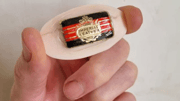Experts reveal new COVID-19 sub-variants that may spark surge in cases
By
Danielle F.
- Replies 20
As the seasons shift and the chill of winter approaches, Australians are not only pulling out their warm coats but also bracing for the inevitable sniffles and coughs that accompany the colder months.
However, this year, there's an added concern on the horizon: a new set of COVID-19 sub-variants, which health experts warn could drive a fresh wave of cases during flu season.
The FLiRT sub-variants are descendants of the JN.1 variant—an offshoot of the aggressive Omicron variant.
The sub-variants have already made headlines across the US and Europe.
Professor Catherine Bennett, the Epidemiology Chair of Deakin University, noted that these sub-variants have been detected in Australia since February.
Fortunately, the population was shielded thanks to immunity from recent infections and vaccinations.
Yet, FLiRT's highly transmissible nature is expected to fuel the next wave of infections, with a peak anticipated around June.
The symptoms associated with FLiRT are likely to mirror those of other COVID variants.
However, the severity can vary from person to person.
'It still has the potential to make people very sick,' Professor Bennett emphasised.
She urged citizens to update their boosters, which remain the best defence in the coming weeks and months as the following COVID wave approaches.
Vaccinations, she reminds us, can be the difference between a mild illness and a hospital stay.
One of the FLiRT sub-variants, KP.2, became the dominant coronavirus strain in the US.
According to US Centers for Disease Control and Prevention (CDC) data, over a quarter of their recent COVID cases were of this variant.
A related variant, KP.1.1, is responsible for about seven per cent of cases.
'We learned from the laboratories that FLiRT variants appeared, so far, to be as transmissible as the other Omicron sub-variants, which means they're quite contagious,' Dr William Schaffner, an infectious disease expert at Vanderbilt University, shared.
In previous news, healthcare experts warned about the possible rise of triple-threat viruses that may affect Australians during winter.
COVID cases have seen a 37 per cent increase, along with the rise of respiratory syncytial virus (RSV).
In light of these developments, authorities and healthcare professionals urged people to get vaccinated for the flu and to stay home if feeling unwell.
Professor Bennett also suggested that it 'pays to think about' a return to mask-wearing, especially for public transport and those more vulnerable to illness.
'I'd prefer to wear a mask than have an infection,' she stated.
SDC member @Lissu2 agreed with the healthcare precaution: 'I am the same, wearing masks in crowded places, always carry sanitiser.'
As we navigate this new wave of COVID cases, staying informed and proactive about our health is essential.
We encourage members to consult with their healthcare providers about the best course of action, whether getting the latest booster shot or adopting preventive measures like mask-wearing in crowded places.
Stay safe and well, members!

What do you think about this new COVID variant? What safety measures are you applying to keep you and your family safe? Share your thoughts in the comments below.
However, this year, there's an added concern on the horizon: a new set of COVID-19 sub-variants, which health experts warn could drive a fresh wave of cases during flu season.
The FLiRT sub-variants are descendants of the JN.1 variant—an offshoot of the aggressive Omicron variant.
The sub-variants have already made headlines across the US and Europe.
Professor Catherine Bennett, the Epidemiology Chair of Deakin University, noted that these sub-variants have been detected in Australia since February.
Fortunately, the population was shielded thanks to immunity from recent infections and vaccinations.
Yet, FLiRT's highly transmissible nature is expected to fuel the next wave of infections, with a peak anticipated around June.
The symptoms associated with FLiRT are likely to mirror those of other COVID variants.
However, the severity can vary from person to person.
'It still has the potential to make people very sick,' Professor Bennett emphasised.
She urged citizens to update their boosters, which remain the best defence in the coming weeks and months as the following COVID wave approaches.
Vaccinations, she reminds us, can be the difference between a mild illness and a hospital stay.
One of the FLiRT sub-variants, KP.2, became the dominant coronavirus strain in the US.
According to US Centers for Disease Control and Prevention (CDC) data, over a quarter of their recent COVID cases were of this variant.
A related variant, KP.1.1, is responsible for about seven per cent of cases.
'We learned from the laboratories that FLiRT variants appeared, so far, to be as transmissible as the other Omicron sub-variants, which means they're quite contagious,' Dr William Schaffner, an infectious disease expert at Vanderbilt University, shared.
In previous news, healthcare experts warned about the possible rise of triple-threat viruses that may affect Australians during winter.
COVID cases have seen a 37 per cent increase, along with the rise of respiratory syncytial virus (RSV).
In light of these developments, authorities and healthcare professionals urged people to get vaccinated for the flu and to stay home if feeling unwell.
Professor Bennett also suggested that it 'pays to think about' a return to mask-wearing, especially for public transport and those more vulnerable to illness.
'I'd prefer to wear a mask than have an infection,' she stated.
SDC member @Lissu2 agreed with the healthcare precaution: 'I am the same, wearing masks in crowded places, always carry sanitiser.'
As we navigate this new wave of COVID cases, staying informed and proactive about our health is essential.
We encourage members to consult with their healthcare providers about the best course of action, whether getting the latest booster shot or adopting preventive measures like mask-wearing in crowded places.
Stay safe and well, members!
Key Takeaways
- Health experts predicted that new COVID-19 sub-variants, nicknamed FLiRT, will drive a fresh wave of COVID-19 cases this winter.
- The FLiRT sub-variants are highly transmissible descendants of the JN.1 variant and have been detected in Australia since February.
- Vaccines remain the best protection against the predicted surge in cases, and updates to boosters are recommended to keep people out of the hospital.
- Alongside the rise in COVID cases, flu and other respiratory virus cases are increasing, which prompted authorities to encourage vaccinations and other preventive measures in public spaces.










